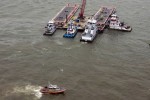http://www.commondreams.org/headline/2014/04/09-6
Published on Wednesday, April 9, 2014
Report on four year anniversary of worst oil disaster in US history details fourteen ailing species
– Jacob Chamberlain, staff writer
See powerpoint slide show at: http://www.slideshare.net/NationalWildlife/deepwater-horizonfouryearslater-nationalwildlifefederation?utm_source=slideshow02&utm_medium=ssemail&utm_campaign=share_slideshow

Photo: Jacqueline Orsulak / National Wildlife Federation
Nearly four years after BP’s Deepwater Horizon oil catastrophe, plants, animals, and fish in the Gulf of Mexico are still reeling from the toxic spill, according to a report released Tuesday by the National Wildlife Federation.
The report, which arrives just ahead of the disaster’s anniversary, examined 14 species of wildlife in the Gulf and found ongoing impacts of the disaster that could last for decades.
“Four years later, wildlife in the Gulf are still feeling the impacts of the spill,” said Doug Inkley, senior scientist for the National Wildlife Federation. “Bottlenose dolphins in oiled areas are still sick and dying and the evidence is stronger than ever that these deaths are connected to the Deepwater Horizon. The science is telling us that this is not over.”
According to the findings, in 2013 dolphins were dying at three times normal rates, with many suffering from “unusual lung damage” and immune system problems.
In addition to the ongoing plight of dolphins in Gulf waters, the researchers found that every year for the past three years roughly five hundred dead sea turtles are found near the spill, “a dramatic increase over normal rates.” These sea turtles only recently recovered from near extinction—a recovery that has now been drastically threatened by the spill.
“The Kemp’s ridley sea turtle has long been the poster child for the possibilities of restoration in the Gulf,” said Pamela Plotkin, associate research professor of oceanography at Texas A&M University and director of Texas Sea Grant. “Once close to extinction, it has rebounded dramatically over the past thirty years. But four years ago, the numbers of Kemp’s ridley appear to have flat-lined. We need to monitor this species carefully, as the next few years will be critical.”
According to the report, sperm whales in the area are showing higher levels of “DNA-damaging metals” than others in other parts of the world—”metals that were present in oil from BP’s well.”
In addition, deep sea coral colonies, which “provide a foundation for a diverse assortment of marine life,” within seven miles from the site of the spill, were still “heavily impacted.”
Other findings, as stated by the group, include:
Oyster reproduction remained low over large areas of the northern Gulf at least through the fall of 2012.
A chemical in oil from the Deepwater Horizon spill has been shown to cause irregular heartbeats in bluefin and yellowfin tuna that can lead to heart attacks, or even death.
Loons that winter on the Louisiana coast have increasing concentrations of toxic oil compounds in their blood.
“Despite what BP would have you believe, the impacts of the disaster are ongoing,” said Sara Gonzalez-Rothi, the National Wildlife Federation’s senior policy specialist for Gulf and coastal restoration. “Last year, nearly five million pounds of oiled material from the disaster were removed from Louisiana’s coast. And that’s just what we’ve seen. An unknown amount of oil remains deep in the Gulf.”
The Gulf oil disaster—which is the worst in U.S. history—”will likely unfold for years or even decades,” NWF writes. “It is essential that careful monitoring of the Gulf ecosystem continue and that mitigation of damages and restoration of degraded and weakened ecosystems begin as soon as possible.”
Despite the ongoing travesty the Environmental Protection Agency announced last month that it removed its ban on BP contracts in the U.S. and new drilling leases, including in the Gulf of Mexico.
Shortly after, the oil giant won bids to start new drilling operations in two dozen separate locations, a total pricetag of $54 million.


